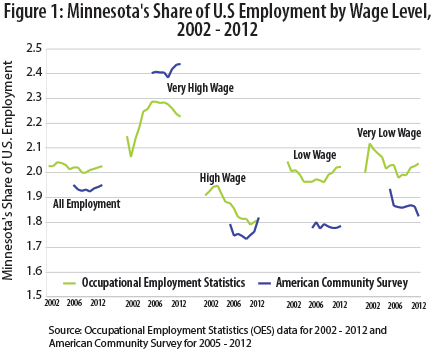
By Dave Senf
December 2013
A record number of Minnesotans are working, but their occupations and how much they are paid are changing as the state transitions to a knowledge-based economy.
In case you haven't been paying attention lately, more Minnesotans than ever before are getting up each day and heading off to work. Both of Minnesota's monthly employment gauges have recently recorded all-time monthly highs on a seasonally adjusted basis. Minnesota's nonfarm wage and salary employment reached a record high of 2.79 million in August, while household employment reached a record high 2.83 million in May.1 New monthly highs for both employment series should become more common now that pre-recession peaks have been topped and job growth is on pace toward a 13-year high in 2013.
You may be wondering why the variation in employment estimates in those two measures. The big difference is that household employment includes self-employment, while wage and salary employment excludes the self-employed. There is also the place of residency versus place of employment divergence, the differing treatment for holding multiple jobs, and the farm versus nonfarm difference.2 By either measure, however, employment has recovered from the Great Recession. Household employment has climbed 128,000 from its August 2009 low, while wage and salary employment has increased 165,000 since bottoming out in September 2009.
Job growth during the recovery, however, hasn't been an exact mirror image of job loss during the recession. While employment levels are a little above or slightly below pre-recession levels for most Minnesota sectors, payroll numbers are way below pre-recession levels in manufacturing and construction and significantly above pre-recession levels in health care and social assistance, private education services and management of companies. Manufacturing and construction jobs are down by double-digit percentages since 2007, while health care and social assistance, private education services and management of companies jobs are up by double-digit percentages since 2007.
As Minnesota's industrial mix of employment shifts, the state's occupational mix also shifts. Jobs in occupations concentrated in expanding industries increase while jobs in occupations concentrated in shrinking industries decrease. Roughly half of all Minnesota manufacturing employment is in production occupations, while construction occupations account for 64 percent of construction sector employment. Education, training and library occupations make up 52 percent of private education jobs, while 50 percent of jobs in the health care and social assistance sector are in either health care practitioners or health care support occupations.
Minnesota's occupational mix has obviously shifted some over the last four years, reflecting the industry mix shift that occurred during and after the recession. Shifting occupational mix, however, is not breaking news. The state's occupational mix is continuously shifting with the economy. Both the Minnesota and national economies are undergoing a long-running structural transformation from industry-based to knowledge-based economies. The Great Recession accelerated the transformation that has been ongoing over the last three decades.
Tracking shifts in Minnesota's occupational mix, especially relative to the U.S. occupational mix, is a handy tool for gauging Minnesota's success in transitioning into a knowledge-based economy. Occupational employment in Minnesota is available from two surveys, the Occupational Employment Statistics (OES) survey and the American Community Survey (ACS).3 One key difference between the two surveys is that OES collects occupational data from employers, while occupational data in ACS is collected from workers. The other key difference is that OES excludes the self-employed, while ACS includes the self-employed.
Minnesota's occupational employment for 2012 as reported by the two surveys is shown in Table 1, with the 800 occupations in Minnesota aggregated into 22 major occupational groups. The third and fourth columns measure how Minnesota's occupational mix compares with the national mix based on the relative employment shares of each occupational group. Management occupations in OES accounted for 6.1 percent of all employment in Minnesota, compared with 4.9 percent nationally. Minnesota has a 25 percent higher concentration of management occupations than the U.S.
Meanwhile, legal occupations as a percent of total employment are lower in Minnesota (0.7 percent) than nationally (0.8 percent). Minnesota's lower share translates into the state having 14 percent fewer legal occupation jobs than the country as a whole. Minnesota has a higher concentration of jobs in 10 occupational groups than the U.S. and a lower concentration in 12 occupational groups.
Are the 10 occupational groups in Minnesota with higher employment concentrations the right kind of jobs that offer better pay and stronger growth outlooks than nationally?
Insight into what kind of jobs are being created in Minnesota compared with the U.S. is provided by sorting occupational groups into four wage levels - very high, high, low and very low - based on 2012 median annual earnings and tracking employment of the four wage groups over time relative to national growth. The wage group assignment for each occupational group is listed in the last column in Table 1.
| Minnesota's Occupational Mix Relative to U.S. Occupational Mix - 2012 | |||||||
|---|---|---|---|---|---|---|---|
| - | OES - 2012 Employment | ACS - 2012 Employment | OES - 2012 Relative to U.S. | ACS - 2012 Relative to U.S. | OES - 2012 Annual Median Wage | ACS - 2012 Median Annual Earnings | Wage Category |
| Total Employment | 2,641,110 | 2,786,812 | - | - | 37,593 | 35,789 | - |
| Management | 161,560 | 296,708 | 25 | 11 | 96,104 | 62,491 | Very High |
| Legal | 17,750 | 26,611 | -14 | -18 | 78,929 | 62,332 | Very High |
| Health Care Practitioners and Technical | 153,280 | 162,474 | -1 | 3 | 65,123 | 52,256 | Very High |
| Computer and Mathematical | 83,090 | 85,693 | 15 | 19 | 76,594 | 69,589 | Very High |
| Business and Financial Operations | 143,980 | 158,421 | 11 | 20 | 61,194 | 54,331 | Very High |
| Architecture and Engineering | 50,850 | 54,619 | 6 | 8 | 70,487 | 68,565 | Very High |
| Protective Service | 41,870 | 37,710 | -36 | -39 | 38,621 | 41,406 | High |
| Life, Physical and Social Science | 23,600 | 27,639 | 5 | 14 | 60,484 | 50,231 | High |
| Installation, Maintenance and Repair | 89,390 | 84,152 | -13 | -8 | 44,176 | 41,638 | High |
| Education, Training and Library | 153,110 | 165,940 | -10 | -2 | 45,333 | 35,519 | High |
| Construction and Extraction | 81,230 | 120,116 | -20 | -14 | 49,853 | 39,571 | High |
| Community and Social Service | 49,930 | 55,763 | 31 | 22 | 41,223 | 38,225 | High |
| Arts, Design, Entertainment, Sports and Media | 38,400 | 55,024 | 8 | 3 | 43,548 | 34,560 | High |
| Transportation and Material Moving | 161,020 | 162,744 | -9 | -5 | 32,440 | 29,546 | Low |
| Production | 214,480 | 199,499 | 23 | 19 | 33,989 | 31,607 | Low |
| Office and Administrative Support | 400,220 | 369,232 | -8 | -2 | 34,954 | 30,740 | Low |
| Health Care Support | 93,160 | 67,802 | 17 | -5 | 26,973 | 21,362 | Low |
| Farming, Fishing and Forestry | 3,220 | 18,721 | -63 | -5 | 28,415 | 22,691 | Low |
| Sales and Related | 271,500 | 289,207 | -3 | -5 | 26,608 | 30,606 | Very Low |
| Personal Care and Service | 105,200 | 109,808 | 36 | 7 | 22,850 | 16,240 | Very Low |
| Food Preparation and Serving Related | 223,370 | 144,952 | -5 | -10 | 19,001 | 11,207 | Very Low |
| Building and Grounds Cleaning and Maintenance | 80,910 | 93,977 | -6 | -17 | 24,129 | 17,204 | Very Low |
| Source: Occupational Employment Statistics (OES) and American Community Survey (ACS) | |||||||
Minnesota's share of national employment as measured by the two surveys has been on the upswing over the last few years after tailing off a bit during the middle of the last decade (see Figure 1). The state's share of national employment was 2.03 percent for OES employment and 1.95 percent for ACS employment in 2012. Minnesota's lower share of ACS employment compared with the OES share suggests self-employed jobs account for a smaller share of employment in Minnesota than nationally. Put another way, wage and salary jobs in Minnesota account for a larger share of employment than nationally.

Minnesota's share of very-high-wage jobs has tailed off since 2006 based on OES data, but has climbed sharply since 2010 based on ACS data. Minnesota's share of very-high-wage occupations is higher than its share of total employment. The opposite holds for high-wage occupations, with Minnesota's share of high-wage employment below the state's share of total employment.
OES data show Minnesota's share of high-wage occupations declining over the last decade. The ACS showed similar declines three years ago but increasing shares over the last few years. The conflicting stories presented by the two occupational surveys are likely due to the two big ways that the surveys differ. Remember, OES excludes self-employed and most agriculture-related employment, while ACS includes self-employed and agriculture-related employment.
One possible theory on why Minnesota is capturing higher shares of very-high-wage and high-wage employment in the ACS data and not in the OES data is that Minnesota's 1099 (freelance, independent contract) economy is expanding at a faster clip than nationally. Minnesota's self-employment in occupations such as management, life sciences, architecture and engineering, education, construction and installation may be increasing faster than nationally, thereby generating Minnesota's increasing share of very-high-wage and high-wage employment in the ACS data. There has been a lot of anecdotal talk of the 1099 economy but little evidence of it in employment data. Perhaps the divergence in the ACS and OES data is hard evidence of expanding 1099 activity.
The two sources of occupational data are also telling divergent stories about Minnesota's low-wage and very-low-wage occupations relative to the nation. The OES data show Minnesota's share of low-wage and very-low-wage occupations increasing since the recession. ACS data show the state's share as flat for low-wage occupations and decreasing for very-low-wage occupations.
Since OES and ACS are survey-based, both datasets inherently have some noise attached. The noise may be the source of the differing trends, or the differing trends displayed by the two occupational datasets may be providing useful information on how Minnesota's labor market is evolving.
1Nonfarm wage and salary employment is also known as payroll, establishment or CES employment. Household employment is also called LAUS (Local Area Unemployment Statistics) employment.
2More information comparing Minnesota employment data.
3For more details on the two surveys, see "A Look at Occupational Data," Minnesota Economic Trends, March 2013.